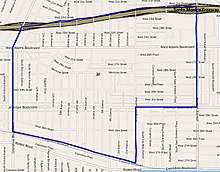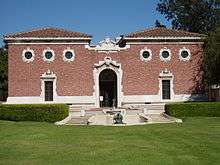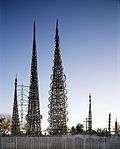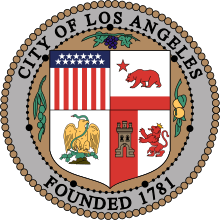Jefferson Park, Los Angeles
Jefferson Park is a neighborhood in the South region of the City of Los Angeles, California.
Jefferson Park | |
|---|---|
Neighborhood of Los Angeles | |
 Jefferson Park city signage located at Jefferson Boulevard and 4th Avenue | |
 Jefferson Park Location within Central Los Angeles | |
| Coordinates: 34.02722°N 118.31667°W | |
| Country | |
| State | |
| County | |
| City | |
| Time zone | UTC-8 (PST) |
| • Summer (DST) | UTC-7 (PDT) |
| Zip Code | 90018 |
| Area code(s) | 323 |
Geography

Jefferson Park is a 1.28-square-mile neighborhood. It is bounded by the Santa Monica Freeway on the north, Crenshaw Boulevard on the west, South Western Avenue and Arlington Avenue on the east and Jefferson Boulevard and Obama Boulevard on the south.[1][2][3][4]
According to the Mapping L.A. project of the Los Angeles Times, The 1.28 square miles (3.3 km2) neighborhood touches Arlington Heights to the north, Adams-Normandie to the east, the Exposition Park residential neighborhood on the southeast, Leimert Park on the south and West Adams to the west.[5]
Jefferson Park contains within it a smaller neighborhood called West Adams Terrace.[1]
History
With development commencing around the turn of the 20th century, Jefferson Park began as one of the city's wealthiest neighborhoods. On the hills rising west of Western Avenue, wealthy white Angelenos built luxury Edwardian, Craftsman, and Art Deco mansions, with churches and commercial buildings of commensurate expense. In 1903 there were trolley cars running down Jefferson and Adams Boulevard.[6] Some wealthy blacks moved into the area as well, leading the neighborhood to be dubbed "Sugar Hill" by many African-Americans of the day. To the south, in the flatter areas along Jefferson Boulevard, a low-rise commercial corridor developed, with small single-story homes and low-rise apartment buildings in the blocks behind. After the 1948 Supreme Court ruling that banned segregationist covenants on property, most of Jefferson Park's white population decamped to other parts of the region, in turn being replaced by upper-middle and upper-class blacks whose descendants still reside in many of the district's spectacular homes.
The Jefferson Park and Jefferson Boulevard area saw an influx of Creole peoples to the Los Angeles area in the post-World War II period.[7][8] The resulting area was dubbed "Little New Orleans" and saw a large population of Creole people and Creole owned businesses such as the Big Loaf Bakery and Harold and Belle’s, an upscale creole restaurant.[9][10] The area and its Creole influence has been mentioned in the 2007 book One Drop: My Father's Hidden Life--A Story of Race and Family Secrets by Bliss Broyard.[11]
The area is undergoing gentrification as young professionals are purchasing the craftsman homes that surround the area, and new shops and restaurants are opening up.[12]
Population
A total of 23,130 people lived in the neighborhood's 1.42 square miles, according to the 2000 U.S. census—averaging 16,300 people per square mile, among the highest population density in the city as a whole. The median age was 31, about the same as the rest of the city.[1]
Within the neighborhood, African Americans made up 46.8% of the population, with Latinos 44.9%, Asian 2.9%, non-Hispanic Whites 2.7% and others 2.7%. Mexico and El Salvador were the most common places of birth for the 32.7% of the residents who were born abroad, considered an average percentage of foreign-born when compared with the city or county as a whole.[1]
The median household income in 2008 dollars was $32,654, considered low when compared with all city and county neighborhoods. The percentage of households earning $20,000 or less was high, compared to the county at large. The average household size of 2.8 people was about the same as the rest of the city. Renters occupied 69.5% of the housing units, and homeowners occupied the rest.[1]
In 2000, there were 1,365 families headed by single parents, or 26.6%, a rate that was high for the county and the city.[1]
Jefferson Park residents aged 25 and older holding a four-year degree amounted to 11.8% of the population in 2000, considered low when compared with the city and the county as a whole; the percentage of residents aged 25 and older with a high school diploma was also considered low.[1]
Education
Schools within the Jefferson Park boundaries are:[2][13]
- Joseph Pomeroy Widney High, LAUSD, special education, 2302 South Gramercy Place
- Twenty-Fourth Street Elementary, LAUSD, 2055 West 24th Street
- Mid City Magnet, LAUSD alternative, 3150 West Adams Boulevard
- Celerity Nascent Charter, LAUSD, 3417 West Jefferson Boulevard
- Sixth Avenue Elementary, LAUSD, 3109 Sixth Avenue
- Holy Name of Jesus Catholic Elementary, private, 1955 West Jefferson Boulevard. The school was founded in 1924 by families from New Orleans. It celebrates its Creole heritage with a music program in which every child in the school learns to read music and to play a musical instrument.[14]
In 2013 24th Street Elementary School in Jefferson Park became the first campus in Los Angeles to make use of a "parent trigger" law that enabled its parents to install a new administration. The school serves a mostly low-income and minority population, and it failed to meet the state's educational standards in English and mathematics.[15] The parents voted to take control of what had been a chronically underperforming school, and they chose to organize it as a hybrid charter school, with the Los Angeles Unified School District operating kindergarten through 5th grade and a private entity, Crown Prep Academy, running grades 5 through 8.[16]
Parks and Libraries

Memorial Library,
2520 Cimarron Street
Landmarks and Attractions
- Auguste R. Marquis Residence. This 1904 Queen Anne-style house — designated the city's 602nd Historic-Cultural Monument in 1994 – was also used to depict exteriors of the Fisher & Sons Funeral Home in the HBO series Six Feet Under. It is located at 2501 Arlington Ave.[20][21]
- Trinity Baptist Church. Originally located at 36th and Normandie, it moved to its present location at 2040 W. Jefferson Blvd. in 1948. The master plan for the church was designed by noted African-American architect Paul Williams.[22][23]
- The First African Methodist Episcopal Church. Considered the spiritual heart of South Los Angeles and the usual venue for funerals of prominent black Angelenos, it is located at 2270 S. Harvard Blvd. It was designed by noted African-American architect Paul Williams and completed in 1968.[24]
Transportation
- The Metro Expo Line has a station in Jefferson Park.
- Metro Local bus routes 14, 35, 37, 38, 207 and 209 also servers Jefferson Park.
References
- "Jefferson Park". Mapping L.A.
- The Thomas Guide, 2006, pages 633 and 673
- "LA City Council unanimously approves South LA street names". www.ktla.com. Retrieved 2017-06-28.
- Reyes-Velarde, Alejandra (April 23, 2019). "Rodeo Road to be renamed Obama Boulevard, with festival where he once campaigned". Los Angeles Times. Retrieved 2019-04-24.
- "South L.A." Mapping L.A.
- Wedner, By Diane (August 10, 2003). "L.A. as it looked a century ago". Los Angeles Times. Retrieved May 5, 2019.
- SNYDER, GARRETT (2019-08-27). "How chicken sausage links became a centerpiece to South L.A.'s black food culture". Los Angeles Times. Retrieved 2019-08-27.
- Carpenter, Jane (2002). Conjure women: Betye Saar and rituals of transformation, 1960-1990. University of Michigan. p. 22.
- Campanella, Richard (2006). Geographies of New Orleans. University of Louisiana at Lafayette. p. 215. ISBN 1887366687.
- Thompson, Ginger (February 5, 1989). "Spicy Parties : Set Tone for : Creoles' Life in Southland". Los Angeles Times. Retrieved September 7, 2013.
- Broyard, Bliss (2007). One+Drop:+My+Father's+Hidden+Life--A+Story+of+Race+and+Family+Secrets#v=snippet One Drop: My Father's Hidden Life--A Story of Race and Family Secrets. Back Bay Books. ISBN 978-0316019736.
- Khouri, Andrew. "Soaring home prices spur a resurgence near USC". Los Angeles Times. Archived from the original on May 1, 2014. Retrieved May 1, 2014.
- http://www.hnojla.org www.hnojla.org
- Reuters (16 January 2013). "Parent Trigger Law At LAUSD: 24th Street Elementary School The Target Of New Parent Petition" – via Huff Post.
- "Parents Take Control of School".
- "Parks | City of Los Angeles Department of Recreation and Parks". Laparks.org. Retrieved 2018-10-04.
- "Parks | City of Los Angeles Department of Recreation and Parks". Laparks.org. Retrieved 2018-10-04.
- Los Angeles Public Library, Jefferson Branch
- "Archived copy". Archived from the original on 2017-09-13. Retrieved 2017-07-29.CS1 maint: archived copy as title (link)
- "Archived copy". Archived from the original on 2017-07-30. Retrieved 2017-07-29.CS1 maint: archived copy as title (link)
- "Newsletter" (PDF). www.westadamsheritage.org. 2015.
- "History" (PDF). www.trinitybaptistchurchofla.org.
- "First African Methodist Episcopal Church - Los Angeles Conservancy". www.laconservancy.org.
External links
| Wikimedia Commons has media related to Jefferson Park, Los Angeles. |
- Jefferson Park Historic Neighborhood Profile at The Los Angeles Conservancy
- LA Times Neighborhoods: Jefferson Park--comment by Greg Jackson, April 18, 2010
- Huell Howser video from 2003 about Jefferson Park in his "Our Neighborhoods" series, hosted by Chapman University, home of the Huell Howser archive.

